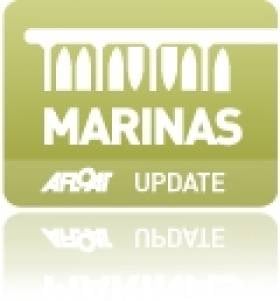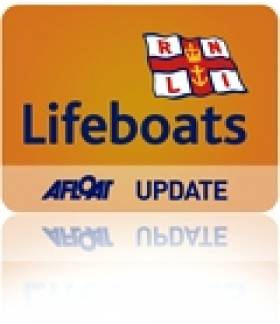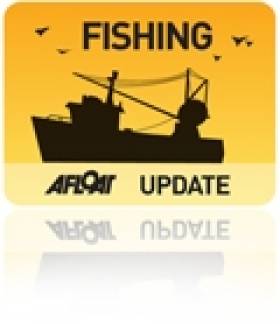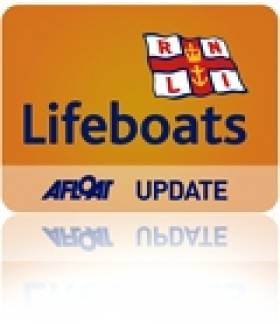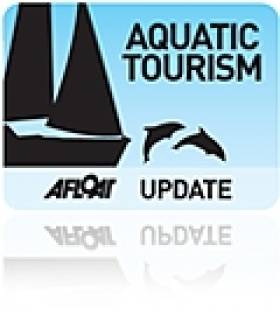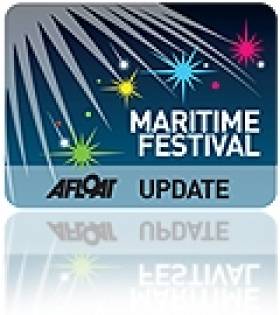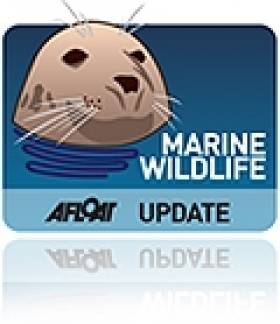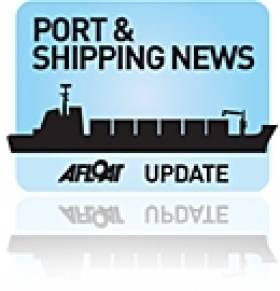Displaying items by tag: Lough Swilly
Rathmullan Marina. Yacht & Boat Berths & Storage on Lough Swilly
Rathmullan marina is a small marina pontoon at Rathmullan, a village in County Donegal is located on the western shore of Lough Swilly and is part of the Fanad Peninsula, situated roughly 12.5 miles from the Lough's entrance and 34 miles northwest of Londonderry/Derry.
The pontoon is suitable for small vessels to berth alongside at a reasonable fee and where fresh water is laid on. There is a concrete slipway suitable for dinghy landing. The Lough Swilly ferry also operates from the pier between Rathmullan and Buncrana, a journey of 45 minutes.
Lough Swilly RNLI Featured On 'Ear to the Ground'
#RNLI - RTÉ’s popular agricultural programme Ear to the Ground paid a visit to Lough Swilly RNLI recently which will feature on this week's episode on Thursday evening.
Set to feature is local man Francis Burns, who along with running a successful farm hoof care business also volunteers with Lough Swilly RNLI’s lifeboat crew.
The programme, which looks at issues concerning agriculture and the rural community, had planned to spend a day with Burns carrying out his job – but when producers heard about his role as a volunteer lifeboat crew member, they decided to include his role with the RNLI too.
Burns and fellow Lough Swilly lifeboat volunteers Eamonn Mahon, Michael Doherty, Tommy Cooper and Francis Bourne showed their guests around the station and demonstrated a lifeboat launch for them.
While most visitors to the station are particularly interested in the RNLI’s Atlantic 85 inshore lifeboat, the Ear to the Ground crew were particularly impressed with the RNLI’s huge custom-built tractor, which the lifeboat crew uses to launch and recover the lifeboat.
The massive tyres are filled with water and antifreeze to make sure it stays on the ground when it enters the water.
Speaking about the filming, Burns said: “I’ve wanted to be a member of Lough Swilly RNLI ever since we got a day off school to come down and see the new all-weather lifeboat arriving at the station.
"Lifeboats are in my family as my cousin George O’Hagan is also the second coxswain on the lifeboat.
"It will be great to be able to show people how lifeboat volunteers can work in the agricultural sector and still be able to train and go out on the lifeboats to help rescue people.”
Programme director Liam Lavelle added: “We are delighted to be able to include the RNLI on Ear to the Ground. It’s a great story about people who volunteer to save lives.
"In our programme we try and reflect what people are doing in rural communities. Many of these communities touch the sea and this work is an important part of Francis’s story."
The programme is due to air on RTÉ One this Thursday evening 31 January at 8.30pm.
High Levels of Sea Lice Detected at Irish Salmon Farms
#FishFarm - Two Irish fish farms were found to have consistently high levels of sea lice over the past six months, according to new figures.
Undercurrent News reports on findings by the Marine Institute which show that a farm owned by Marine Harvest Ireland at Lough Swilly and one operated by the Mannin Bay Salmon Company in Corhounagh were "found to have levels of sea lice which exceed the Marine Institute's protocol level of two pregnant female lice per fish."
Sea lice levels at the Lough Swilly site in particular climbed from an average of 4.35 per fish to a high of 71.72 in September before dropping to a still-high 44.88 last month.
A statement issued by Marine Harvest played down concerns over the new figures, noting that "treatment trigger levels are set a low level" in Ireland compared to other countries, and that it uses "tried and tested procedures" to deal with such infestations.
It added that lice numbers can rise and fall in tandem with changes in climate, as experienced in the latter months of 2012.
As reported on Afloat.ie last month, a new international study says some 39% of salmon mortalities can be attributed to the impact of sea lice - predominantly from fish farms - on wild salmon fisheries.
In a press release, Don Staniford of lobby group the Global Alliance Against Industrial Aquaculture (GAAIA) said: “The Irish Government should be controlling sea lice infestation on salmon farms not promoting even bigger feedlots such as the proposed 15,000-metric-ton farm in Galway Bay.”
Undercurrent News has more on the story HERE.
Lough Swilly RNLI Rescues Crew From Stricken Fishing Boat
#RNLI - Lough Swilly RNLI rescued five people onboard a 50ft fishing boat yesterday evening (Sunday 2 December) after the vessel’s engine broke down in Co Donegal.
During what was a nine-hour callout in tough weather conditions, Portrush RNLI also launched to assist the stricken Mary Ellen.
Volunteer crew members from Lough Swilly had been attending a commemoration in Portsalon when they were requested to launch to the boat that had broken down some 10 miles further on, a mile-and-a -half from Fannad Lighthouse.
The all-weather Tyne class lifeboat arrived on scene at 3.15pm where the crew observed a steel crabber with five men onboard. The fishing boat was carrying a load of crab.
Weather conditions at the time were described as blowing gusts of between gale force 5 and 6 up the lough.
The crew pursued to establish a towline and commence the return journey to shore. After towing the vessel for a couple of hours into the dark, the tide began to turn, making the pull more difficult. A relief lifeboat from Lough Swilly and Portrush RNLI were requested to launch to assist.
Irish Coast Guard helicopter Rescue 118 was also on scene in the event that the stricken vessel’s crew would need to be evacuated.
As the boat was being towed up the lough it lost all power and VHF was transferred from the lifeboat for communication.
When Portrush RNLI arrived on scene, the crew assisted with the tow while the Lough Swilly relief lifeboat stood by.
The stricken vessel’s mechanic managed to restart the engine during the tow and the vessel made its way into Rathmullan while the Lough Swilly lifeboat stood by in case it required further assistance.
John McCarter, Lough Swilly RNLI lifeboat operations manager, paid tribute to the lifeboat crew who arrived back at the station in the early hours of Monday morning.
"This was a long callout in difficult weather conditions and we are glad that we were able to assist this vessel and her crew in making it to shore safely,: he said.
"This was a testament of the commitment, skill and selfless nature of our volunteers who are always willing to give their time and readily leave the comfort of their homes to face challenging conditions to help people who find themselves in difficulty at sea."
Joe Joyce from the lifeboat crew told BBC News that the nine-hour operation was "an unpleasant experience" but reported that "everybody was safe and well".
Watersports a Big Attraction on Lough Swilly
#TOURISM - Sailing, kayaking and surfing are just some of the attractions for watersports enthusiasts in Rathmullan, as the Sunday Independent reports.
Sophie Linehan visited the Donegal village on the shores of Lough Swilly ahead of last weekend's second annual SeaFest, which introduced novices to the delights of various aquatic sports.
And it wasn't hard for her to find a whole host of activities for all levels of experience.
Many of these are available at the not-for-profit Rathmullan Sailing and Watersports School, set up by American transplant Rick Le Vert - who 10 years ago had never been sailing himself!
Linehan and her companion were shown the ropes in an afternoon sailing taster session on the lough, which she describes as "the perfect place to learn to sail".
Lessons in surfing and stand-up paddle boarding are also easily availed of - the latter being a great introduction to those who might be a bit scared of the surf.
The Sunday Independent has much more on the story HERE.
SeaFest Lough Swilly To Celebrate Second Year
#MARITIME FESTIVALS - The second SeaFest Lough Swilly is set to take place next weekend from 22-24 June, as the Donegal Democrat reports.
“SeaFest Lough Swilly is an event for everyone,” said Mark Wheeler of Rathmullan House, one of the weekend's organisers.
“For sailors and watersports enthusiasts, be they experienced or novice; for families in search of something active to do with the kids; for people who simply take pleasure in being at the seaside; and of course for everyone who enjoys good local food.”
The non-profit festival will let watersports novices sample the delights of windsurfing, sailing, paddle boarding, snorkelling and sea kayaking.
For landlubbers, meanwhile, there will be traditional vintage fairground games, local produce from the Donegal Country Markets, crafts from Donegal Designer Makers and musical acts performing all weekend.
Food is also a big aspect, with Mulroy Bay oysters, spit-roasted Donegal organic pork, Lough Swilly mackerel and Irish craft beers all on the menu.
What's more, Saturday 23 June will see the second annual running of the Saldanha Cup, a traditional cruiser-racer sailing regatta that commemorates the 200th anniversary of the sinking of the frigate HMS Saldanha.
And you never know - the SeaFest might even have some killer visitors, if last week's orca encounter is anything to go by!
The Donegal Democrat has more on the story HERE.
Killer Whales Surround Anglers in Lough Swilly
#MARINE WILDLIFE - The video above shows the moment when an angling boat was surrounded by a pod of killer whales at the mouth of Lough Swilly in Co Donegal.
Sea angler Kevin Doherty, whose boat was treated to the spectacle, told UTV News: "We knew ourselves at that moment we were going to witness something special."
Local wildlife experts say the orca family came from the Scottish Hebrides and as well known - but this is the first time the whole family group has been recorded together on Ireland's North coast.
Donegal Ferry Services Under Review
The cross-border service is funded by Donegal County Council and Limavady Borough Council. The route in recent years has experienced an unfavourable exchange rate, increased cost of fuel, poor weather, a depressed tourism market sector and notably reduced construction traffic, contributing to a sharp decline in demand. In the current climate the local authorities may find it difficult to provide funding as they scale back on budgets.
Record levels in 2005/2006 saw traffic reach 106,179 vehicles and 302,740 passengers. Such was the success of the service annual subsidies for 2008 and 2009 were not required. According to the latest 12-monthly traffic figures for June 2009-June 2010, vehicle volumes dropped to 52,669 and passengers levels have decreased more than halve to 149,455.
The 10-minute route is operated by the 44-vehicle capacity Foyle Venture which served the Kilimer-Tarbert route for the Shannon Ferry Co. The mid-west estuary ferry was replaced by newbuild Shannon Breeze in 2000 and later sold to Lough Foyle Ferry Co.
When the Lough Foyle route began operations in 2002, the service received a subvention of €108,000 each from the local councils. Over that timeframe, the route has received a total funding of €500,000 from Donegal County Council.
In 2009, the two local authorities agreed to provide a €200,000 subvention, but this runs out in March 2011. An application has also been submitted to the Special EU Programmes Body for funding.
On the west side of the Inishowen Peninsula is the Bunbcrana-Rathmullan service, which is also in doubt if a subsidy from Donegal County Council cannot be maintained. The Lough Swilly route started in 2004 and is served by the 20-vehicle capacity Foyle Rambler, a former German river-ferry. The north-west ferry route takes 25-minutes and recorded 15,000 passengers at its peak.
In busier times, tourists from the North, instead of passing through Derry city, used the 'land-bridge' routes across the Inishowen Peninsula to reach holiday-homes and popular seaside resorts throughout Co. Donegal.


























